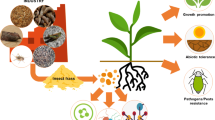Abstract
Culture and mass production of exotic phytoseiid predators is one component of a classical biological control programme directed toward the cassava green mite (CGM), Mononychellus tanajoa, in Africa. Five species of phytoseiid predators are currently maintained at the International Institute of Tropical Agriculture, Euseius concordis, Galendromus annectens, Neoseiulus anonymus, N. idaeus and Typhlodromalus limonicus. CGM from cassava and two-spotted spider mites, Tetranychus urticae, reared on mucuna, peanut and cowpea plants, are harvested as phytoseiid food using a mite brushing machine or a water based mite separator unit. Stock maintenance cultures are initiated at regular intervals, have a definite productive period and are used as a source for mass-rearing phytoseiids for release in Africa. Mass-rearing techniques utilizing artificial substrates, detached leaves and entire plants, in the insectary and field, are being developed.
Résumé
L’élevage et la production de masse de phytoséiides prédateurs exotiques est l’une des composantes d’un programme de lutte biologique classique contre l’acarien vert du manioc, Mononychellus tanajoa, en Afrique. Cinq espèces de phytoséiides prédateurs sont actuellement élevées à l’Iita: Euseius concordis, Galendromus annectens, Neoseiulus anonymus, N. idaeus et Typhlodromalus limonicus. Les acariens verts infestant les plants de manioc et Tetranychus urticae élevé sur mucuna, sur l’arachide et le niébé sont récoltés en vue d’alimenter des phytoséiides à l’aide d’un dispositif à brosses ou d’un appareil opérant par séparation en milieu aqueux. Les élevages de souche sont régulièrement renouvelés. Ils ont une période de production bien définie et sont utilisés pour l’élevage de masse des phytoséiides lâchés en Afrique. Des techniques d’élevage de masse sur substrats artificiels, feuilles détachées et plantes entières sont en voie d’élaboration en insectarium et au champ.
Similar content being viewed by others
References
Gilstrap F. E. (1977) Table top production of tetranychid mites (Acarina) and their phytoseiid natural enemies. J. Kan. Ent. Soc. 50, 229–233.
McMurtry J. A. (1982) The use of phytoseiids for biological control: progress and future prospects. In Recent Advances in Knowledge of the Phytoseiidae (Edited by Hoy M. A.), pp. 23–48. Div. Agric Sci., Univ. of Calif, Berkeley Publ. 3284.
McMurtry J. A. (1983) Phytoseiid predators in orchard systems: a classical biological control success story. In Biological Control of Pests by Mites (Edited by Hoy M. A., Cunningham G. L. and Knutson L.), pp. 21–26. Div. of Agric. and Nat. Res., Univ. of Calif., Berkeley. Spec. Publ. 3304.
McMurtry J. A., Huffaker C. B. and van de Vrie M. (1970) Ecology of tetranychid mites and their natural enemies: A review. I Tetranychid enemies: their biological characters and the impact of spray practices. Hilgardia 40, 331–390.
van den Bosch R., Messenger P. S. and Gutierrez A. P. (1982) An Introduction to Biological Control. Plenum Press, New York and London.
Yaninek J. S. and Aderoba O. T. (1986) Culture maintenance. In IITA Annual Report for 1985. Ibadan, Nigeria, pp. 70–71.
Author information
Authors and Affiliations
Rights and permissions
About this article
Cite this article
Friese, D.D., Megevand, B. & Yaninek, J.S. Culture Maintenance and Mass Production of Exotic Phytoseiids. Int J Trop Insect Sci 8, 875–878 (1987). https://doi.org/10.1017/S1742758400023109
Received:
Published:
Issue Date:
DOI: https://doi.org/10.1017/S1742758400023109




